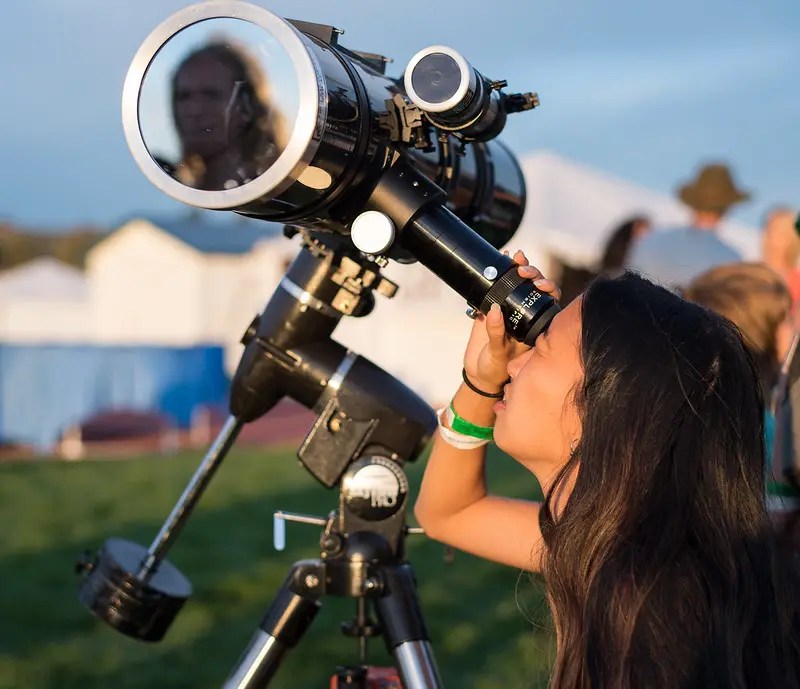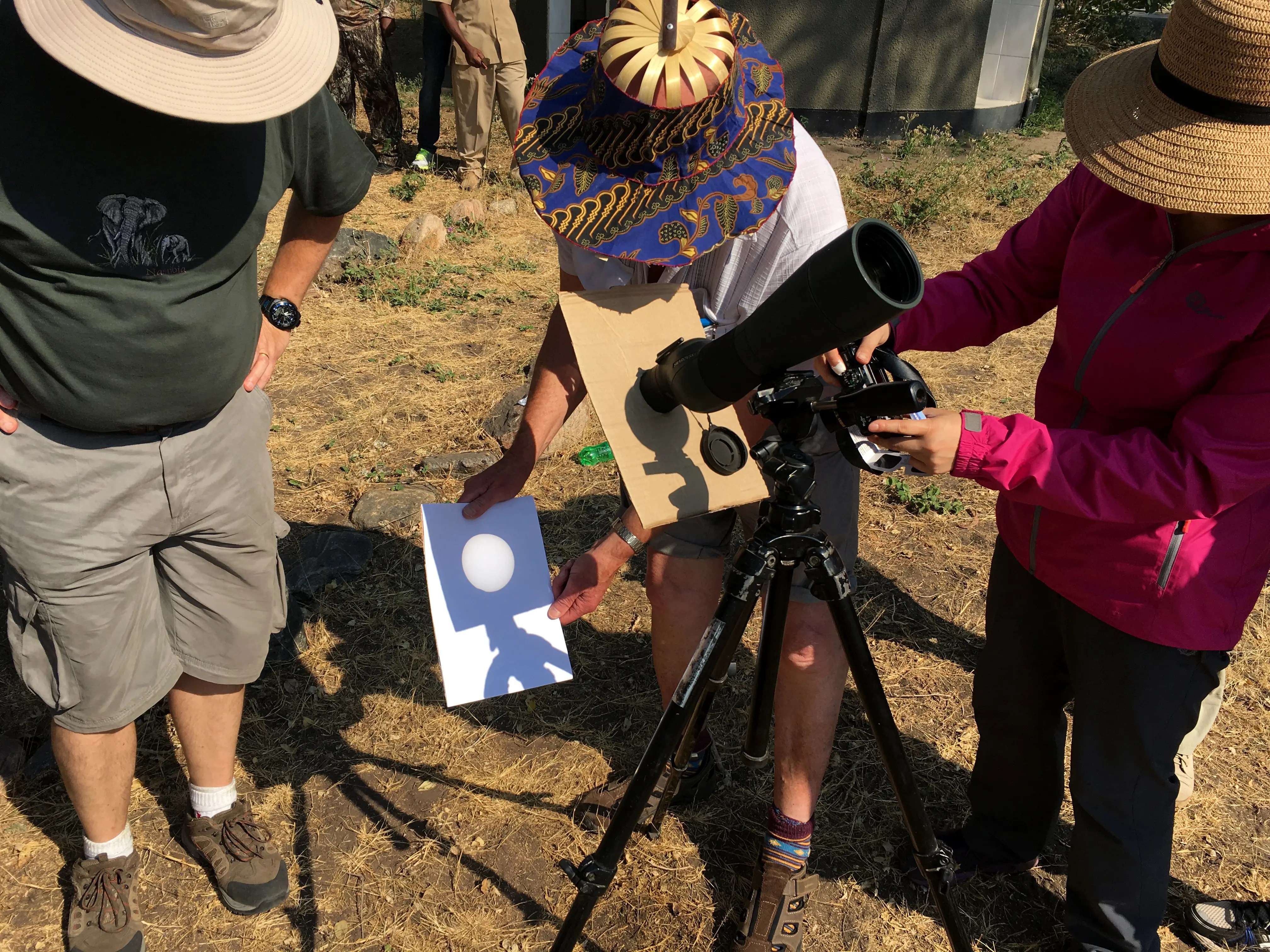Do you want to host a gathering during the next solar eclipse?
Or do you simply want to have an event to enjoy and celebrate the Sun?
Here are some tips and ideas for your Sun party, which you can host any time whether there’s an eclipse in your area or not!

People use handheld solar viewers and solar eclipse glasses to safely view a solar eclipse.
National Park Service
- a large outdoor space where people will be able to see the Sun during your event (avoid being too close to buildings or trees that could block your view of the Sun)
- a shady or cool place where guests can take a break from the Sun
- restroom facilities that are sufficient for all of your guests
- trash and recycling bins
- basic first-aid supplies for any minor injuries
- parking spaces for guests’ vehicles, if needed
- volunteers to help you set up beforehand and clean up afterward
- sunscreen
- bug repellant
- hats
- drinking water
- chairs or blankets to sit on
- large, white sheets of paper (or white pillowcases or bedsheets) to project images of the Sun onto
- materials needed for event activities
- Make sure you have permission to hold your party at your desired location.
- If you’re timing your party to take place during an eclipse, check the times of the eclipse for your location. (Check with a local science museum or planetarium, use NASA’s eclipse map, or visit other online maps such as this.)
- Find out where in the sky the Sun will be during your event so that your guests will be able to view it without obstruction from trees or buildings. Do this by visiting your planned event site on a sunny day beforehand (within a couple weeks of your event) at the same time as your event and note where in the sky the Sun is. (Remember: Do NOT look directly at the Sun without eye protection!)
- Order safe solar viewing glasses (also called eclipse glasses) or handheld solar viewers for your guests that meet the ISO 12312-2 standard (or encourage guests to bring their own).
- Reach out to a local astronomy club to ask whether one of their members would be willing to operate a special solar telescope at your party (perhaps offer them free food and drinks as incentive) or whether they’ll have solar telescopes set up for public viewing somewhere nearby on the day of your event.
- Review safety guidelines for viewing the Sun (during an eclipse or anytime).
- Practice viewing the Sun safely.
- Invite your guests and provide the location, date, and the start and end times for your Sun party. Also tell them what to expect and what, if anything, they should bring.

A Sun watcher views the Sun through a telescope with a specialized solar filter attached to the end for safe solar viewing.
NASA/Aubrey Gemignani

A telescope safely projects an image of the Sun onto a piece of paper.
NASA/Ryan Milligan
- Safely view the Sun with solar viewing (or “eclipse”) glasses.
- Ask an experienced telescope operator to provide views of the Sun through a telescope equipped with a solar filter specially designed and certified for viewing the Sun. Or ask them to project a view of the Sun through a solar telescope onto a piece of paper or a large screen for guests to view indirectly.
- Visit NASA’s Solar and Heliospheric Observatory (SOHO), Solar Dynamics Observatory (SDO), or Solar Terrestrial Relations Observatory (STEREO) websites to see what the Sun looks like right now (and compare your observations). Check back often to see how the Sun changes during your event.
- Make sunspot cookies.
- Make aurora hummus or Sun dip.
Activity
Safe and Stylish Solar Eclipse Glasses
Kids of all ages can decorate or add to their eclipse glasses. Here's an example activity for inspiration.
View Activity
- Play Sun-related or eclipse-themed music.
- Play a Sun- or eclipse-related NASA video playlist on a computer, laptop, or large screen (perhaps inside or in a shady area to avoid glare). Check out NASA’s Heliophysics YouTube channel or the NASA Scientific Visualization Studio’s Heliophysics Gallery for some ideas.
- Record video or audio interviews of your guests talking about the Sun or the eclipse, or record their reactions to viewing it (with their permission).
- Share pictures of your Sun party on social media and tag @NASASun on X and @NASA Sun Science on Facebook.
- Make a pinhole projector (with a cereal box or shoe box, or by punching one or more small holes in a thin piece of cardboard or an index card and projecting sunlight through the holes onto the ground). Watch how the projected image of the Sun changes shape throughout the partial phases of the eclipse.
- Stream NASA’s live eclipse broadcast (or another eclipse livestream), especially as a backup in case there are clouds covering the Sun in your area.
- Use black-and-white sandwich cookies to make eclipse cookies that mimic what the eclipse looks like in your location.
- Try this Big Sun, Little Moon activity to see how something relatively small (like the Moon) can appear to cover something much larger (like the Sun).
- Take photographs of the landscape at regular intervals to capture how the light changes during the eclipse, or take photos of the Sun using a solar filter affixed to the front of your camera to show how it becomes more eclipsed and then less eclipsed.
- Just before and after a total eclipse, look at a large, white sheet of paper or other flat, white surface for black, wavy shadows called shadow bands.
- Journal your eclipse experience with words or drawings to capture what you see, hear, feel, smell, and taste during the eclipse.
Have fun, and remember to enjoy the Sun safely and responsibly in adherence to all local laws and guidelines!
Keep Exploring





